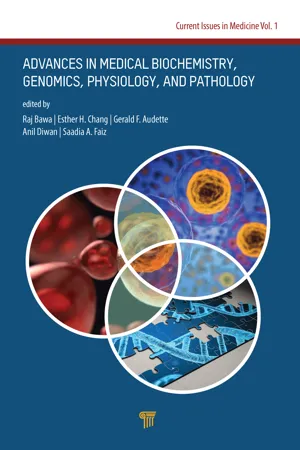
Advances in Medical Biochemistry, Genomics, Physiology, and Pathology
- 666 pages
- English
- ePUB (mobile friendly)
- Available on iOS & Android
Advances in Medical Biochemistry, Genomics, Physiology, and Pathology
About This Book
The pace and sophistication of advances in medicine in the past two decades have necessitated a growing need for a comprehensive reference that highlights current issues in medicine. Each volume in the Current Issues in Medicine series is a stand?alone text that provides a broad survey of various critical topics—all accomplished in a user-friendly yet interconnected format. The series not only highlights current advances but also explores related topics such as translational medicine, regulatory science, neglected diseases, global pandemics, patent law, immunotoxicology, theranostics, big data, artificial intelligence, novel imaging tools, combination drug products, and novel therapies. While bridging the gap between basic research and clinical medicine, this series provides a thorough understanding of medicine's potential to address health problems from both the patient's and the provider's perspectives in a healthcare setting. The range of topics covered and the expertise of the contributing authors accurately reflect the rapidly evolving areas within medicine—from basic medical sciences to clinical specialties. Each volume is essential reading for physicians, medical students, nurses, fellows, residents, undergraduate and graduate students, educators, policymakers, and biomedical researchers. The multidisciplinary approach of the series makes it a valuable reference resource for the pharmaceutical industry, academia, and governments. However, unlike other series on medicine or medical textbooks, this series focuses on current trends, perspectives, and issues in medicine that are central to healthcare delivery in the 21st century. Volume 1 focuses on the current issues in basic medical sciences, subjects that are fundamental to the practice of medicine. Specifically, it covers medical biochemistry, genomics, physiology, and pathology. These subjects, traditionally taught in the first two years of medical school that precede clinical instruction, provide a core of basic knowledge critical to the success in clinical medicine during rotations, training, and medical practice.
Frequently asked questions
Information
Chapter 1The Age of COVID-19: Medical Facts and Fiction



1.1 Emerging Pathogens: A Clear and Present Danger
Messieurs, c’est les microbes qui auront le dernier mot. (Gentlemen, it is the microbes who will have the last word.)—Louis Pasteur
Epidemics on the other side of the world are a threat to us all. No epidemic is just local.—Peter Piot

Table of contents
- Cover
- Half-Title Page
- Title Page
- Copyright Page
- Dedication
- Table of Contents
- Corresponding Authors
- Note from the Series Editor
- 101. Engraving of the Bust of Hippocrates; Papyrus Fragment Showing the Hippocratic Oath; Facade of the Temple of Asclepius
- 1. The Age of COVID-19: Medical Facts and Fiction
- Section 1 Medical Biochemistry and Genomics
- Section 2 Human Physiology and Pathology
- Index